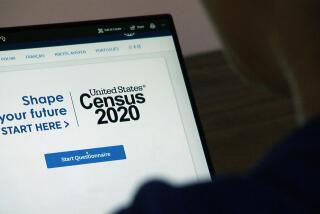Everything you need to know about the 2020 census
WASHINGTON — The 2020 census is underway and by now you should have gotten information about how to fill it out.
Have questions about the census and what it is for? No shame, it’s been 10 years and a lot is different this time around. Let’s take a look at what you need to know.
So what is the census?
Article 1, section 2 of the Constitution requires the federal government to count every person living in the country every 10 years and use the information to divvy up representation in Congress. The census is that count, and it happens at the start of each new decade.
Is this where I have to wait until someone knocks at my door and asks me questions?
That’s how it used to be for everyone. But nowadays that is highly unlikely.
Then how does it work?
The government is hoping you save it (i.e. taxpayers) money by filling it out online at https://my2020census.gov/. Since that the cheapest and fastest way to participate, officials hope most people opt for it.
Wait, I can do it online?
Yup. Starting March 12, the census can be completed online for the first time. Every home will get a postcard or letter with an identification number and instructions about whether they should fill the census out online, by phone or by mail. But you have to wait until you get a postcard or letter, which should have arrived by March 20.
What if I don’t want to do it online?
The postcard or letter has details about answering the census by phone. If English is your primary language you can call (844) 330-2020. Census takers can also take your information by phone in multiple languages. Otherwise, the government will mail you a paper census form.
Whatever way you do it, the Census Bureau estimates it should take 10 minutes to fill out. The survey is available in 13 languages: English, Spanish, Chinese, Vietnamese, Korean, Russian, Arabic, Tagalog, Polish, French, Haitian Creole, Portuguese and Japanese.
What happens if I do nothing?
Then you can expect to have a census taker knocking on your door as soon as early May. The federal government has hired thousands of people to follow up with people who don’t respond online, by phone or mail, and to count homeless people, college students and other hard-to-reach groups.
The spread of the coronavirus, and concerns about the safety of census workers, has delayed some of that outreach. It’s another reason the government really wants you to fill it out online.
Federal law actually requires you to respond to the census. It’s important for everyone to avoid what is known as an undercount, which could lead to fewer government services and less government representation in areas where residents are not included in the census, but still use the road, schools and other services.
What information do they want?
The main thing the government wants to know is who lives in your residence as of April 1, including children, parents, tenants, friends or whomever.
It will ask for your name and phone number, how many people live in the home, and if it is owned or rented. It will also ask for the name, sex, date of birth, ethnicity and race of each person living in the home, and how they are related. Don’t leave some questions blank. Filling out only part of the census is a good way to ensure a census worker will come by your house to follow up.
A sample version of the official 2020 Census form
Isn’t it illegal to ask about race and ethnicity? Can I decline to answer?
No, it’s been on the form a long time, and it has a purpose.
The census has asked people whether they are of Hispanic origin, and which broad Hispanic group they identify with, since 1970. The census has collected racial data since 1790.
The 2020 census gives people 15 racial categories and a write-in option. It also allows you to select more than one race.
This information is used to enforce rules against race-based discrimination and determine how many people are eligible for programs like the Indian Health Service.
Will they ask about the citizenship of people living in the house?
No, and this was a big legal fight last year. The Trump administration tried to add a citizenship question to the census, but critics sued to block it. Census experts warned that asking about citizenship might discourage immigrant households from participating, leading to an undercount in states like California with large immigrant populations.
The Supreme Court blocked the Commerce Department from adding the question, ruling that the Trump administration failed to give an adequate reason for the change. So there will not be a citizenship question on the form.
Why should noncitizens be counted?
Everyone has to be counted regardless of their citizenship or legal status in the country. Federal courts have repeatedly upheld that the drafters of the Constitution demanded a count of all “persons” in the country.
The Census Bureau has a website addressing questions on this issue.
How is my information used?
The census results are used for reapportionment, which is the term for redrawing legislative and congressional districts so every district represents about the same number of people in the state Legislature or Congress.
The country’s population has grown faster in the South than on the West Coast in the last decade, and because Congress is limited to 435 representatives in the House, California is expected to lose at least one seat in Congress.
But census results are used for much more than drawing legislative and congressional districts. Over the next 10 years, the information will be used to decide how much federal money states and cities receive for Medicare, Head Start, reduced price school lunches, highway construction and other federal programs.
About $675 billion in federal funds is distributed each year based on the census. California received an estimated $172 billion in census-directed federal funding in fiscal 2017 alone, according to a recent George Washington University study.
Local governments also use the data to decide things like where schools, fire stations and new roads should be built, and even small but important things, like where stop signs and fire hydrants are placed.
Businesses use it to decide where to build and expand, or shrink. Nonprofits use it to determine where people who need their help are located.
Will my personal information be shared?
No. Under federal law, no identifying information can be shared with any other federal agency, including immigration, law enforcement and the courts. Only general statistics that result from the census, like how many children live in a community, can be shared between agencies and publicly.
Every census employee takes an oath not to share any identifying information taken during the census. If they do, they potentially face fines and jail time.
Your answers do become public eventually, but you might not be around to know.
Under the government’s “72-year rule” the National Archivist must wait 72 years after census day before releasing personally identifiable information from a census, as anyone who has searched their family ancestry has discovered. Genealogy buffs will get access to the 1950 census results in April 2022.
More to Read
Get the L.A. Times Politics newsletter
Deeply reported insights into legislation, politics and policy from Sacramento, Washington and beyond. In your inbox three times per week.
You may occasionally receive promotional content from the Los Angeles Times.











